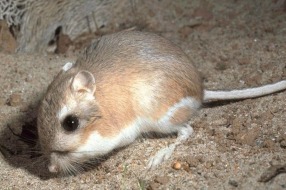All About Deserts
The Kangaroo Rat

The kangaroo rat are small rodents that live in the North American deserts. It's genus is dipodomys.
Obtaining Energy
The Kangaroo Rat usually eats a diet of seeds,leaves, and other green vegetation. Although they also eat insects. They practically never drinks water because of it's scarcity.
Obtaining Energy
The Kangaroo Rat usually eats a diet of seeds,leaves, and other green vegetation. Although they also eat insects. They practically never drinks water because of it's scarcity.
Ridding Waste
The kangaroo rat's kidneys are remarkable. They concentrate the urine so that it becomes almost solid, this reduces water loss. Kangaroo rats also lack sweat glands, so they don't loss water through evaporation by perspiring.
Using Energy
The kangaroo rat would usually be seen scavenging for more seeds or tiny insects. The rats most distinctive feature of the kangaroo rat is it's long back legs. The kangaroo rat hops like a kangaroo.
Reproduction
Kangaroo mating season is from January to May. Kangaroo rats mature in about 12 to 13 weeks. A kangaroo rats duration of pregnancy time is 32 days, and it's birth interval is 4-6 months. Some have 2-3 litters a year with 1-7 offspring, but usually 2 in a liter.
Growth and Development
At birth, young Kangaroo rats toothless, hairless, and wrinkled. Their eyes and ears are closed as well. They show the color pattern of adults in different shades of pink. Young males grow faster than females in terms of mass.
Adaptations to Immediate Changes in Environment
Kangaroo rats have very unique kidneys that help it reduce water loss. Kangaroo rats have very long hind legs that help it maneuver around. Most have hairy soles on their hind feet that help aid it in jumping in loose, soft sand. Some have four toes on the hind feet, while other have five. The short forefeet have strong claws for digging burrows.
